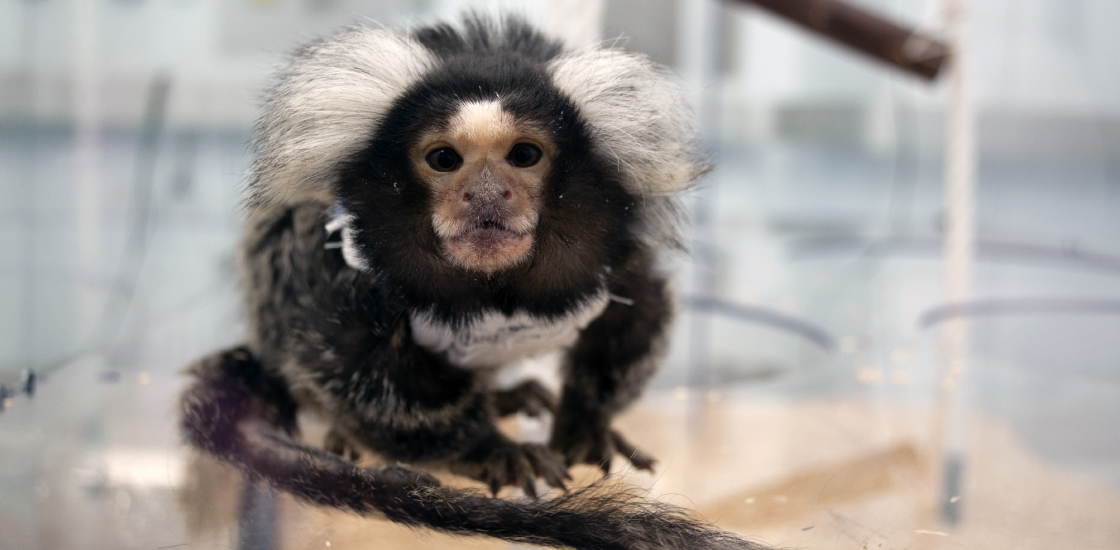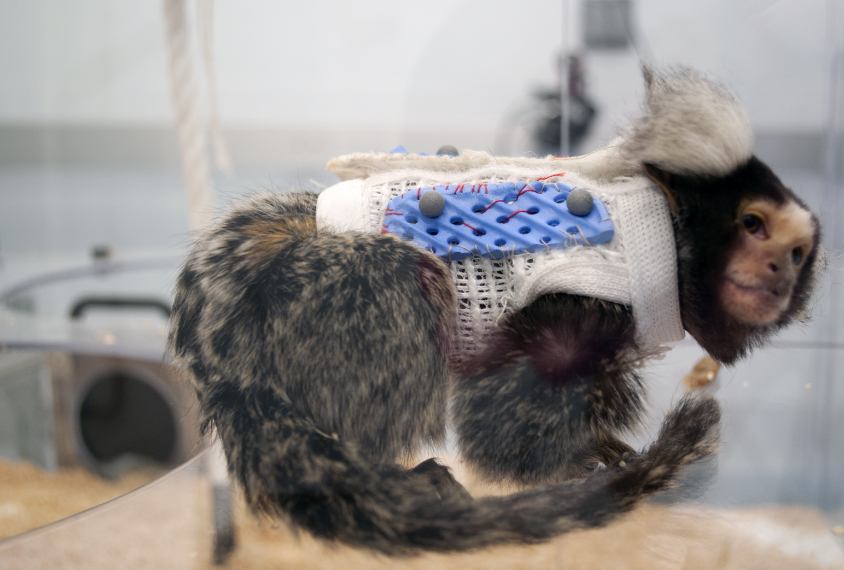Monkey motion-capture reveals social behavior in 3-D
A monkey-sized jacket embedded with motion sensors — similar to technology used to animate creatures in movies — is helping researchers develop the common marmoset as a model for studying human social behavior.

It takes about two weeks for a marmoset to get used to wearing a jacket embedded with motion sensors, coaxed along by strategically placed bits of monkey chow, the occasional marshmallow and the skilled hands of a graduate student.
Once the jacket is on, it’s ‘Lights, camera, action!’: The researchers are using motion-capture technology similar to that used to animate the character Gollum in “The Lord of the Rings” to track the subtleties of marmoset social behavior.
This work was just one of several studies presented over the past few days at the 2018 Society for Neuroscience annual meeting in San Diego, California.
Native to the forests of northeastern Brazil, marmosets are tree-dwelling animals. Their small size, intricate kin relationships and frequent reproduction have made them an increasingly popular model for studying human social behavior. But their popularity means that scientists need reliable, quantitative ways to measure their development, vocalization and behavior.
The motion-tracking jackets are part of an elaborate test for social behavior based on an often-used rodent test of sociability. In that test, researchers place a mouse in a box divided into three chambers, one of which contains an unfamiliar mouse. They track how much time the mouse spends in the chamber with the stranger.
The marmoset version is bigger and better. Marmosets have much sharper vision than rodents. So, whereas a mouse displays social interest by sniffing another mouse up close, a marmoset might keep its distance and stare.
The researchers designed a plexiglass cage with four levels. The monkeys can climb ropes to get to higher levels or jump down through holes in the platforms to get to lower ones. A plexiglass box at the bottom of the cage holds an object of potential social interest: a stuffed dummy monkey or another live marmoset.

Marmosets “like to spend most of their time in trees,” says Diego Buitrago-Piza, a graduate student in Julio Martinez-Trujillo’s lab at Western University in London, Ontario, who presented the work. That translates to the upper levels of the box. “If they’re [socially] interested, they go down and check.”
Marmoset medley:
Other teams are working on rubrics for tracking infant marmoset development. These will be critical for evaluating transgenic marmosets bearing autism-linked mutations.
“My vision is to create a test battery to know whether mutants are different,” says Rogier Landman, a research scientist in Robert Desimone’s lab at the Massachusetts Institute of Technology in Cambridge, Massachusetts.
Landman and his colleagues have created a marmoset version of a newborn assessment commonly used in people. They are also tracking vocal development in marmoset infants — for example, describing how the ‘phee’ call, which monkeys make when they cannot see members of their group, becomes more defined over time.
That refinement depends on parental involvement, according to work from Steffen Hage’s lab at the University of Tübingen in Germany. The team showed last year that three marmosets separated from their parents within the first three months of life still made infant cries as adults1.
An unpublished analysis reveals that their vocal development is ‘stuck’ at the age at which they were separated from their parents, says Yasemin Gültekin, a graduate student in Hage’s lab who presented the work. The findings add heft to an emerging picture that marmosets, like people, learn to vocalize by interacting with others of their kind.
A marmoset’s repertoire of trills, twitters, phees, trillphees and other calls also involves some of the same brain regions as language does in human brains, work from Xiaoqin Wang’s laboratory at Johns Hopkins University in Baltimore, Maryland, shows.
Another connection to human social behavior: Marmosets follow the gaze of other monkeys, displaying joint attention, a skill often impaired in autistic people.
Researchers from Hans-Peter Thier’s lab at the University of Tübingen tracked the eye movements of marmosets as they viewed pictures of another marmoset looking either to the left or to the right. About 300 milliseconds after a picture flashes into view, the monkeys tend to make brief eye movements called saccades in the direction of the pictured monkey’s gaze, says Silvia Spadacenta, a postdoctoral fellow in Thier’s lab who presented the work.
My precious:
Martinez-Trujillo and his colleagues have so far tried their motion-capture social test in two male marmosets and one female.
When a monkey wearing the motion-capture jacket is inside the test cage, 14 cameras arranged around the cage record its movements, and software turns the sensor data into a rendering of the animal’s movements and orientation. “You can precisely track when they look up, down, around,” Martinez-Trujillo says. “You just put on these jackets and see how they interact.”
The researchers tracked each monkey for 15 minutes as it interacted with either a stuffed monkey, an adolescent marmoset, an adult of the same sex, an adult of the opposite sex or an empty box at the bottom of the cage. Overall, the three monkeys spent a lot of time facing adult monkey visitors, but tended not to orient toward the juvenile, the stuffed monkey or the empty box.
The female monkey showed the most interest in the other adult female, spending long stretches of time right next to the box holding the visitor monkey. One of the males was also interested in a female visitor. This male did not have a female partner in his home cage. The other male, who did have a mate, was not as interested in the female visitor as he was in the other adult male.
Such subtleties add complexity to research, especially as the team sets out to test marmosets bearing mutations linked to autism. But Martinez-Trujillo says it’s worth it: “We need an animal model that replicates social interaction in humans.”
For more reports from the 2018 Society for Neuroscience annual meeting, please click here.
References:
- Gültekin Y.B. and S.R. Hage. Nat. Commun. 8, 14046 (2017) PubMed
Recommended reading

Expediting clinical trials for profound autism: Q&A with Matthew State

Too much or too little brain synchrony may underlie autism subtypes
Explore more from The Transmitter

Mitochondrial ‘landscape’ shifts across human brain

